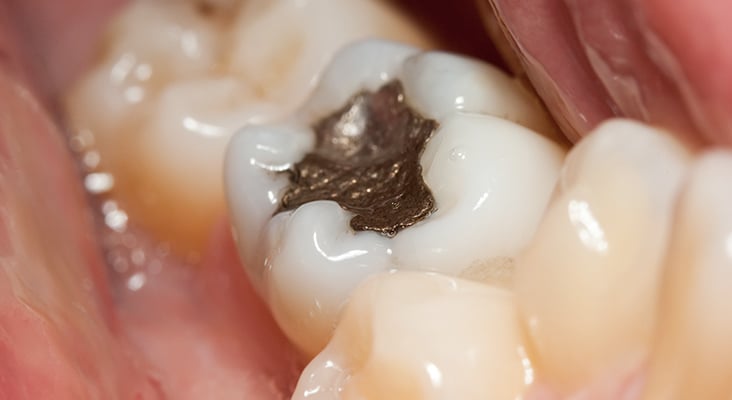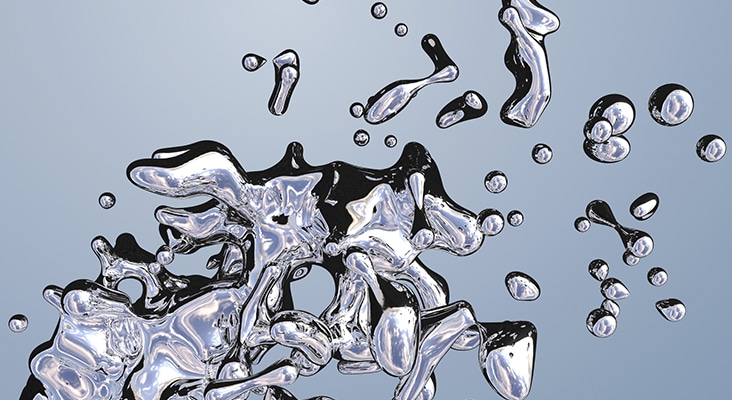Choosing the Right Restorative Material
Dental amalgam has historically been the gold standard of restorative care.

Dental amalgam has historically been the gold standard of restorative care. Recently, however, the use of composites as a restorative option has grown in popularity. In one survey 50% of dentist respondents reported a decrease in amalgam use over the previous 5 years. Composite may seem like the obvious replacement for dental amalgam, but some research shows that it is not as durable or long-lasting as amalgam.
Photo Credit: icefront / iStock / Getty Images Plus

Mercury’s Negative Health Effects
Recently, research has investigated whether the presence of mercury in amalgam has negative health consequences for oral health professionals. Dental professionals are repeatedly exposed to amalgam restorations during both placement and removal. One study surveyed dental assistants who had been practicing since 1970 and were exposed to amalgam restorations. The study reported that, in comparison to a control group, the dental assistants experienced a higher occurrence of neurological symptoms, including memory problems, difficulty concentrating, fatigue, and sleep disturbances. While the majority of the control group did not report these signs, high-quality research is still needed to demonstrate causality.
Photo Credit: dinn / iStock / Getty Images Plus

Environmental Effects
In large quantities, mercury is harmful not only to humans, but also to the environment. The toxic environmental effects of dental amalgam, which contains mercury, must be considered. According to the Environmental Protection Agency, dentists are releasing approximately 5.1 tons of mercury waste each year and serve as the main source of discharge into the environment through publicly owned treatment works, which are essentially government-owned sewage facilities. Besides dental practices, cremation is another culprit in mercury emissions. A 2010 study found the cremation of bodies with amalgam restorations led to the emission of approximately 8,000 lbs of mercury over 1 year.
Photo Credit: piyaset / iStock / Getty Images Plus

Additional Restorative Options
Esthetically pleasing composites, resin ionomers, glass ionomers, ceramic inlays, onlays, and gold alloys serve as alternatives to dental amalgam. For the clinician, the decision is typically based on longevity, while a patient may prioritize cost-effectiveness. Studies have shown that gold restorations have excellent longevity—even more so than dental amalgams—but amalgams are still 3.8 times more cost-effective than a gold crown. Ceramic inlays have a 98% probability of survival over a 7-year period. Glass ionomer restorations also release fluoride, which may be beneficial to particular patient populations. However, the leading cause of glass ionomer restoration failure is secondary caries.
Photo Credit: okan akdeniz / iStock / Getty Images Plus

Downsides of Composites
With the growing popularity of composite restorations, it is clear they are here to stay. However, their increased risk of failure presents a conundrum. Some studies note the location of the bonding agent as a point of weakness and suggest that a more durable anticariogenic dentin adhesive needs to be developed in order to increase composite’s longevity. Other researchers state that additional training for dentists is necessary so they can repair imperfect restorations. Not all dentists are adequately trained in conducting procedures without the use of dental amalgams, or they are skeptical of their effectiveness.
Photo Credit: shironosov / iStock / Getty Images Plus

Role of Dental Hygienists
Dental hygienists should understand the benefits of each type of restorative material so they can best advise their patients. Patients also need instruction on proper self-care in order to support longevity of their restoration. In 2005, more than half of the restorations placed in the US were replacements for failed restorations. Using proper in-office fluoride treatments, such as 5% sodium fluoride varnish, 1.23% acidulated phosphate fluoride, stannous fluoride, and others, can also help to prevent decay. Dental hygienists need to ensure their patients have all of the facts necessary to make informed decisions on their current and future dental needs.

